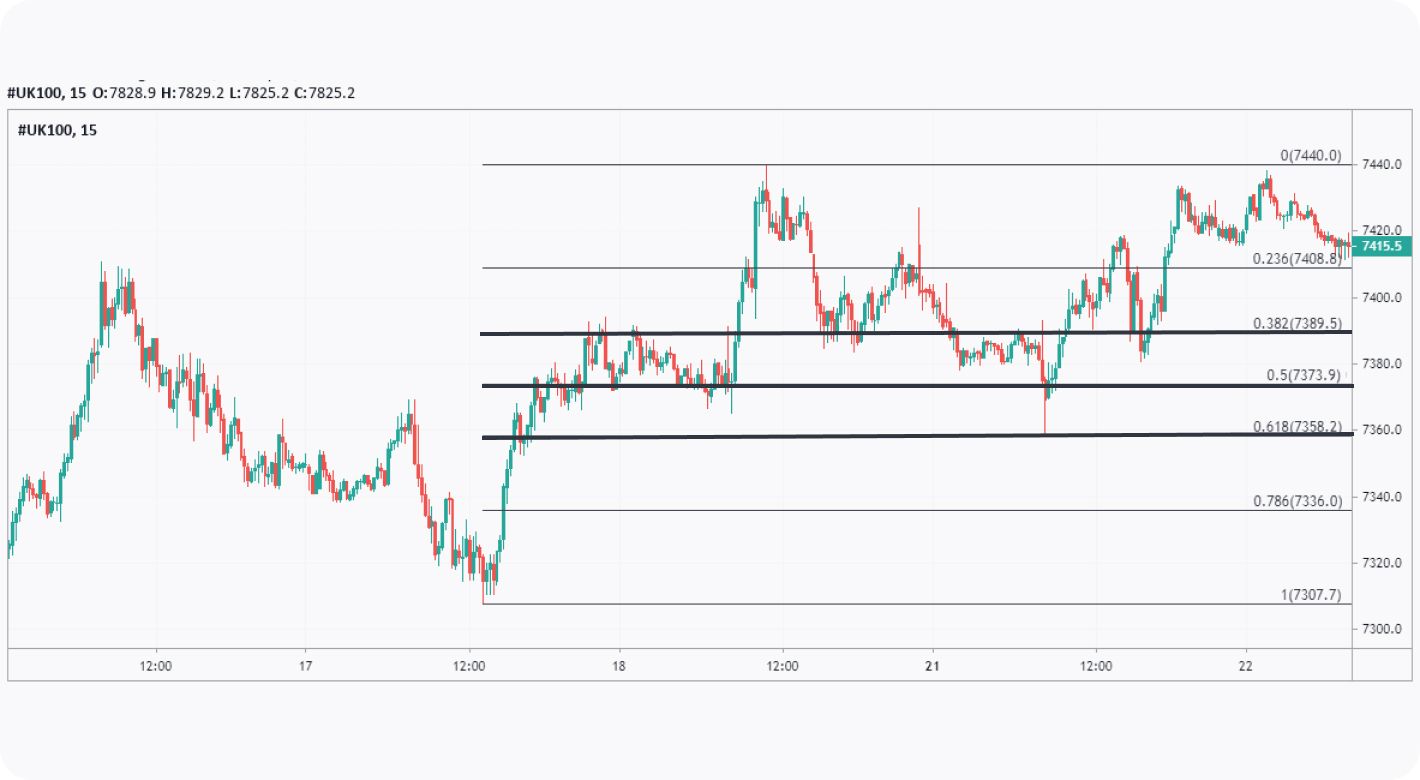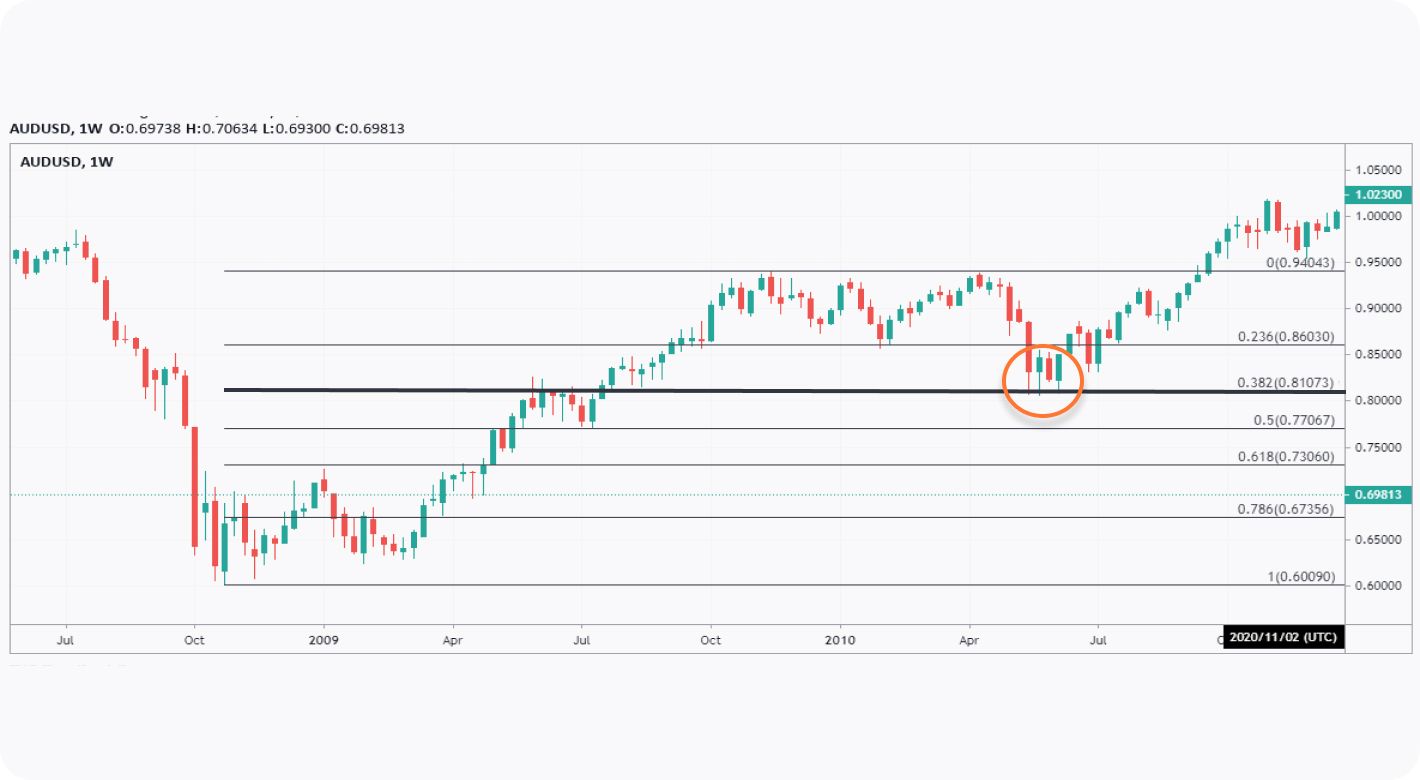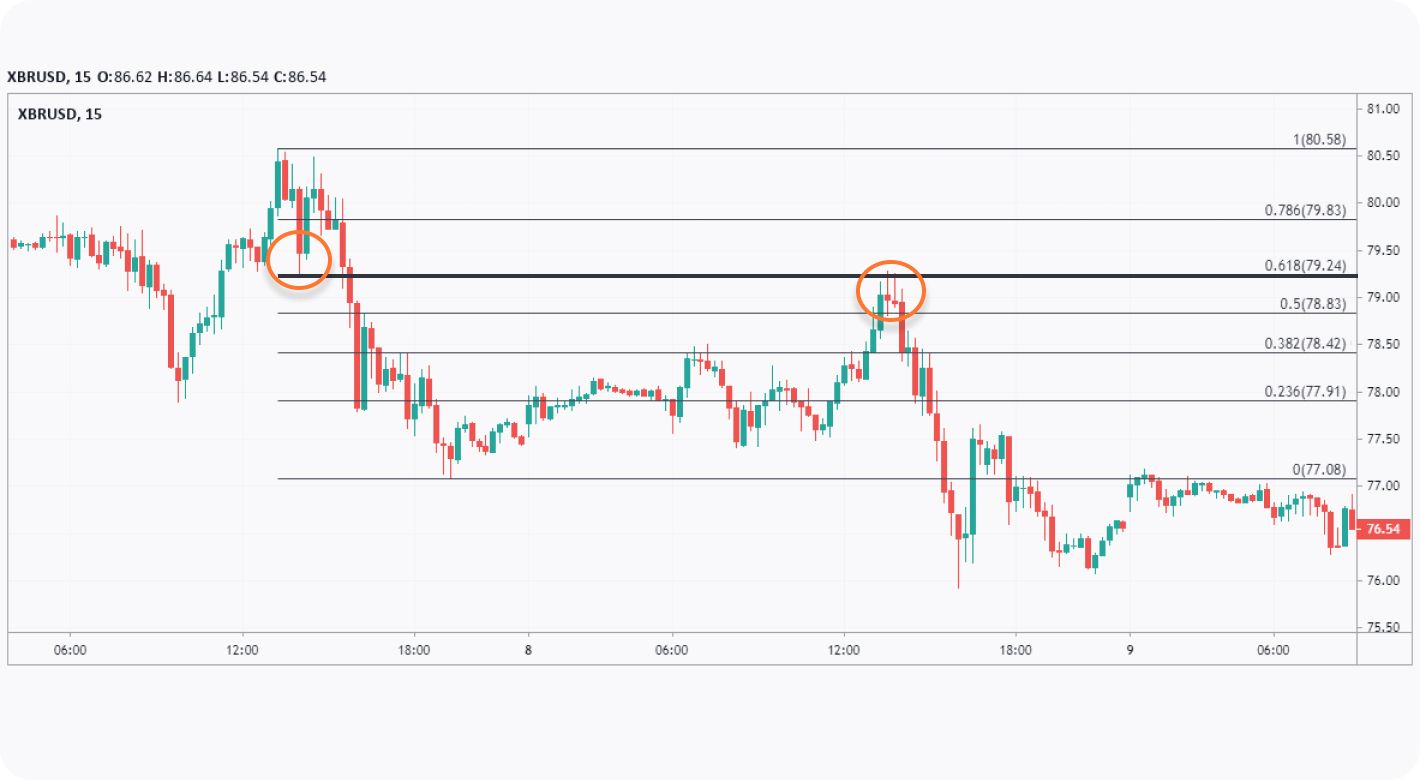FXOpen

If you’re wondering how to trade Fibonacci retracements, you’re in the right place. Today, we’ll be breaking down why traders use Fibonacci retracements and how you can apply them in your own trading, and we’ll list our top tips for making the most out of Fibonacci trading.
The Fibonacci Sequence for Trading
Fibonacci retracements make use of the Fibonacci sequence and the resulting Golden Ratio. Simply put, the Fibonacci sequence is a mathematical concept that starts at 0, then 1, with each following number being the sum of the previous two. It goes 0, 1, 1, 2, 3, 5, 8, 13, 21, 34, and so on.
What we’re interested in is the relationship between the numbers. For example, one number in the sequence divided by the next, like 13/21, will always roughly equal 0.618 (the Golden Ratio). In the case of 13/21, it’s 0.619. As the sequence progresses, the ratio moves closer to 0.618. There are other calculations that we won’t discuss here, but they also give us complimentary ratios of 0.236, 0.382, and 0.786.
Notably, traders typically pay the most attention to the 0.382 and 0.618 ratios. 0.5 is also commonly used, despite not being a true Fibonacci ratio. When using Fibonacci patterns while trading, these ratios are typically expressed as percentages, such as 38.2%, 50%, and 61.8%.
Applying the Fibonacci Numbers to Trading
While these ratios are most often applied to Fibonacci retracements, there are actually quite a few ways to use them. Fibonacci extensions, fans, spirals, channels, and arcs are all advanced techniques commonly used by professional traders.
The Fibonacci ratios are also fundamental to harmonic pattern trading. The ABCD, Gartley, and Bat patterns, amongst others, all use Fibonacci retracements and extensions. Once you get the hang of Fibonacci retracements, learning these patterns could be an excellent next step in developing your Fibonacci skills.
What Are Fibonacci Retracements?

Fibonacci retracements (also termed “fibs”) allow traders to quickly identify key support and resistance levels using the defined ratios. Thankfully, with the advent of charting software like TickTrader, traders no longer need to calculate these key price points manually. Instead, they can apply the visual Fibonacci retracement tool in just a few clicks.
Fibonacci retracements typically work best in trending markets. For example, the tool can be applied to significant swing highs and lows to find areas of support during an uptrend. Once the price cools off, it’ll often retrace to the 38.2%, 50%, or 61.8% levels before continuing the bullish trend.
Like regular support and resistance levels, you can think of the Fibonacci levels as areas of interest rather than a place where the price will reverse with pip-perfect precision. That’s why candlestick and chart patterns are commonly used in conjunction with Fibonacci retracements. Hammers, shooting stars, triangles, and wedges can all provide you with extra confidence that these levels are likely to hold.
How Can Fibonacci Retracements Be Used?
Fibonacci retracements help traders to predict the levels the price might respect in the future. Given their predictive nature, they can help you determine optimal entry points, stop losses, and price targets when trading in the forex market. Fibonacci retracements can be used across all timeframes, from 1-second to monthly charts, thanks to the fractal, or self-repeating, nature of the Fibonacci sequence.
Using Fibonacci Retracements for Trading
Getting to grips with the Fibonacci retracement tool is easy. There are just two key rules to remember:
- If you’re looking for support levels, set the first point at a significant swing low and the second at a significant swing high.
- If you’re looking for resistance levels, set the first point at a significant swing high and the second at a significant swing low.
Let’s take a look at a few examples. If you’d like to try your hand at using Fibonacci retracements, you can use the TickTrader platform offered by FXOpen. You can gain access to live charts and use the built-in Fibonacci retracement tool to get started in minutes.
AUD/USD

We can see AUD/USD on the weekly chart following the 2008 financial crisis. After recovering and putting in months of bullish structure, our swing high and low points have formed. Notice that, upon touching the 38.2% area, the price attempted to close below but was rejected three times, giving us three long wicks. This rejection was an opportunity for traders to identify that further bullishness was inbound, which could’ve influenced their lower timeframe decision-making.
XBR/USD

In this example, Brent Crude Oil has shown signs of bearishness on the 15-minute chart, breaking support and making a lower low. By taking the high and low of this bearish move, we can see that the 61.8% area posed significant resistance, offering two bearish candles that indicated that the price wanted to move lower. Additionally, this area also lines up with a level of support-turned-resistance at 61.8%, giving traders extra confirmation that the area could hold.
GBP/USD

In the chart above, GBP/USD struggled to maintain any bullishness on the daily chart, continually making lower highs and lower lows. By using the most extreme swing low, we can see that a retracement to the 50% area gave traders a chance to get in shortly before a further breakdown. Interestingly, note that the 23.6% level acted as a support before the swing low had even formed. Subsequently, it also offered traders an opportunity to get in on the retest on that level before the price moved lower.
Tips for Using Fibonacci Retracements in Your Trading System
Despite their simplicity, there are a few nuances to learn that can help you when trading Fibonacci retracements.
They’re Not a Silver Bullet
As with any trading tool, using Fib retracements won’t suddenly make every trade you take a winner. It’s merely a predictive tool that can help guide your trades, and it should be used alongside other forms of technical analysis to increase your chances of success.
Wait for Closes to Determine Whether an Area is Suitable to Trade
To ascertain whether an area is holding or not, traders will typically look at the strength of the reaction from the zone. If the price closes through the level cleanly without producing long wicks, then it’s less likely that it’ll reverse. In contrast, if the price is continually rejected and seems to be struggling, then it’s more likely to reverse.
Stick to Your Chosen Timeframe
Related to the last point, use the same timeframe on which you set the Fibonacci retracement to determine whether the area is likely to reverse. If you set it on the 1-hour chart, then look at how it closes on the same timeframe. While tempting, if you switch to the 15-minute or 5-minute charts to see how the price is reacting, it’s likely to provide contradictory signals that will only complicate your analysis.
Be Aware of Higher Timeframe Trends
As with many aspects of trading, it’s always best practice to be cognisant of the higher timeframe trend and trade in harmony with it. For example, if the trend on the daily chart is bullish, looking for bearish retracements to go long on the 4-hour and 1-hour charts will likely yield better results than trying to trade a counter-trend.
Your Next Steps for Creating a Fibonacci Retracements Strategy
If you’re wondering how to create a Fibonacci trading system, you can:
- Spend some time experimenting with the Fibonacci retracement tool on historical price charts.
- Apply Fibonacci retracements to live charts and revisit them to discover how the price reacted at the key levels.
- Once you feel you have a decent understanding of how to use Fibonacci retracements, you can open an FXOpen account and use a free demo account to test them in live markets.
- Take notes of what works and what doesn’t, and begin to formulate a trading strategy.
- Experiment further with indicators you’re familiar with to see if they can provide extra confirmation for your trades.
- Continually practise and refine your strategy until you’re ready to use it for real. Don’t forget risk management.
- Learn more about Fibonacci trading and keep refining your strategy until you’re happy with it.
This article represents the opinion of the Companies operating under the FXOpen brand only. It is not to be construed as an offer, solicitation, or recommendation with respect to products and services provided by the Companies operating under the FXOpen brand, nor is it to be considered financial advice.
Stay ahead of the market!
Subscribe now to our mailing list and receive the latest market news and insights delivered directly to your inbox.








